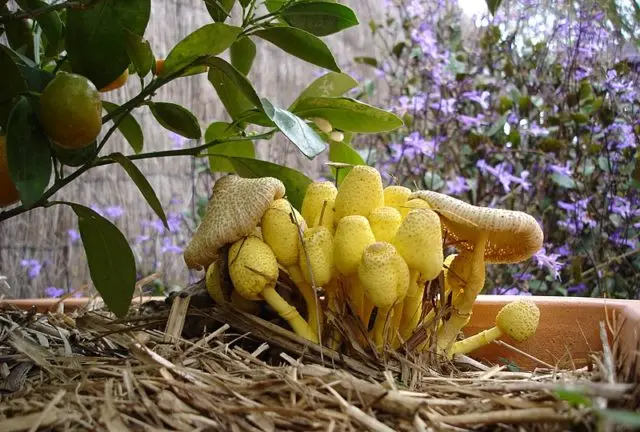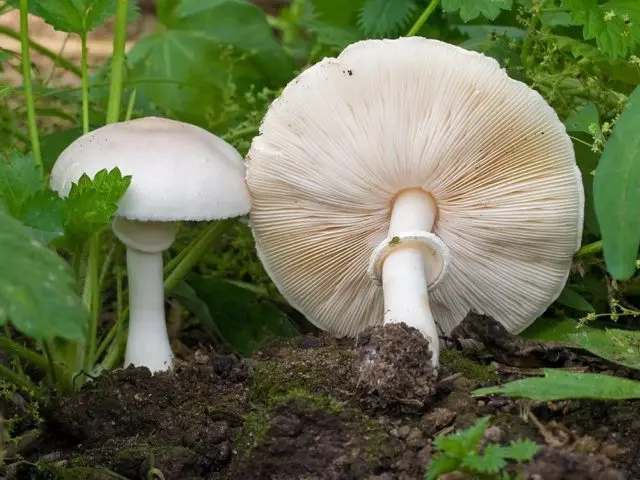Contents
Birnbaum’s white-tailed mushroom is a beautiful bright yellow saprophytic mushroom of the Champignon family of the White-tailed genus. Refers to decorative, grows in greenhouses and in the garden.
Where does Birnbaum’s white dung beetle grows?
The fungus is unpretentious, can grow anywhere where there are suitable conditions. Saprophyte parasitizes on mosses and bark, loves a substrate fertilized with manure, rich in humus soils. In greenhouse conditions (in greenhouses, greenhouses, flower pots) it grows all year round.
It grows wild mainly in North America and Europe, but can grow throughout the world.
What does Birnbaum’s white dungaree look like?
A young specimen has an oval or ovoid cap, which gradually opens up, turns into a conical, bell-prostrate, in mature mushrooms it becomes almost flat. There is a tubercle in the center. The surface is bright yellow, dry, covered with a flaky yellowish coating. The edge is first tucked, then straight with radial striation. Its size reaches a diameter of 1 to 5 cm.

Bright yellow mushroom – a real decoration of the garden
The flesh is yellow, does not change color on the cut. Odorless and tasteless.
The height of the leg reaches 8 cm, the thickness is 4 mm in diameter. The color is the same as the hat. It is usually curved, hollow, expanded at the bottom. In the upper part you can see a ring, which is a remnant of a protective cover – velum. It is yellowish, filmy, narrow, disappearing. Above the ring, the surface is smooth, below it is covered with a coating in the form of yellowish flakes.
Birnbaum’s hymenophore has the appearance of thin plates of sulfur-yellow color, often located, free relative to the stem.
Spores are ovoid or oval-ellipsoid, smooth, colorless, of medium size (7-11X4-7,5 microns). The powder is pinkish.
Belonovozic Pilata. An understudied species that rarely occurs in single specimens. Refers to saprophytes, can grow in any place with a suitable substrate, found in parks, lawns, garden plots, near oaks. Its edibility has not been established, so it is not recommended to collect it. The main difference from Birnbaum’s white dung beetle is its large size, darker color, and the smell of pine nuts in the pulp. The size of the cap is from 3,5 to 9 cm. At first it is spherical, then convex and, finally, prostrate. The surface is reddish-brown, in the center there is a tubercle of intense red-brown color, the edges are thin, in young specimens are turned down, with whitish remains of the veil. The height of the leg is up to 12 cm, the position is central, there is a tuber at the base. In young specimens it is whole, in old specimens it is hollow inside. In the upper part there is a ring, above it it is whitish, below it is reddish-brown. The plates are thin, free, light cream, when pressed, they become reddish-brown. Spore powder is pinkish. The flesh is whitish, pinkish-brown on the cut, has no taste.

Pilate’s white-beaker is distinguished by reddish-brown hats
White champignon blushing. Pretty common. In size, it is larger than the Birnbaum white dung beetle, it belongs to the edible species with good taste characteristics, it has a different color. In the wild, it is found only in the southern hemisphere, and in the northern it is grown artificially. Grows in small groups in mixed forests, pastures, fields, edges, gardens, sometimes single specimens are found. Outwardly, it looks like an ordinary champignon. The hat grows up to 5-10 cm. It is convex, in the center with a small tubercle, straightens out as it grows, the remains of a protective cover are visible on the edge. It can have both thin and thick flesh, white or pale cream. The surface is matte, smooth to the touch, in the old specimen it cracks with the formation of grayish-beige scales in the center. The leg is cylindrical or curved, whitish or grayish, the surface is smooth, there is a white or brown ring. The pulp is fibrous. It grows up to 5-10 cm in length and up to 1-2 cm in thickness. The plates are free, even, frequent, in young ones they are whitish, in mature ones they first turn pink, then darken. Spores are white or pinkish, ovate, smooth. Cream powder. The pulp of the white mushroom is whitish, dense, elastic, with a pleasant aroma of mushrooms.

White champignon blushing – an edible mushroom of white or light cream color
Is it possible to eat Birnbaum’s white dung beetle
The mushroom is inedible. It is not used for food due to lack of nutritional qualities. Performs a decorative function.
Conclusion
Birnbaum’s white-beetle is an inedible mushroom, but it has a very beautiful appearance and bright color, so it is grown in greenhouses for decorative purposes. In greenhouses, it bears fruit all year round.









